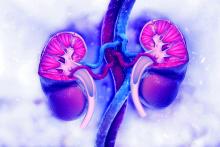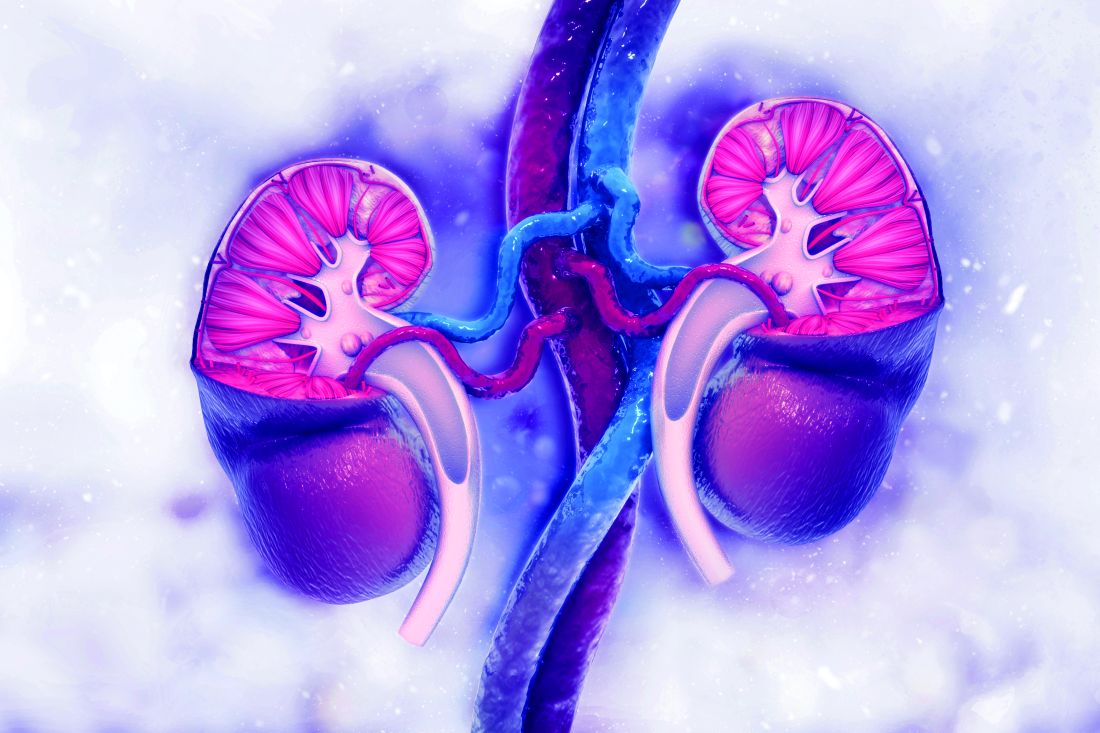User login
Sonographic flow-mediated dilation (FMD) of the brachial artery predicts renal dysfunction in patients with sickle cell disease (SCD), according to investigators.
This is the first study to show that FMD – a surrogate biomarker for endothelial dysfunction – inversely correlates with renal artery resistivity index (RARI) and serum cystatin C, reported lead author Oluwagbemiga Oluwole Ayoola, MBChB, of Obafemi Awolowo University in Ile-Ife, Nigeria, and colleagues.
“[B]rachial artery FMD is an essential test in the management of SCD patients for noninvasive assessment of the vascular endothelium,” the investigators wrote in Kidney360. They went on to suggest that FMD could be used to detect early renal impairment in sickle cell disease.
The study involved 44 patients with steady-state, homozygous SCD (HbSS) and 33 age- and sex-matched controls (HbAA). Eligibility criteria excluded individuals with risk factors for endothelial dysfunction, such as obesity, diabetes, and hypertension, as well as those with thalassemia carrier traits.
For each participant, various data were gathered, including demographic and clinical characteristics, serum assays, FMD measurement of the brachial artery, and RARI.
Results showed that patients with sickle cell disease had a significantly lower median FMD value than that of healthy controls (3.44 vs. 5.35; P = .043).
Among patients with SCD, FMD was negatively and independently correlated with RARI (r = -.307; P = .042) and serum cystatin C (r = -.372; P = .013), correlations that the investigators described as “modest.” FMD was not associated with any other biomarkers of SCD severity, such as homocysteine, fetal hemoglobin, or soluble platelet selectin.
Patients in the SCD cohort were further subdivided into two groups based on an FMD cut-off value of 5.35, which was the median measurement among healthy controls. This revealed that median cystatin C level was significantly higher in patients with an FMD value less than 5.35, compared with those who had an FMD value of 5.35 or more.
“[The study] findings suggest that SCD patients with impaired FMD are more likely to have impaired renal function,” the investigators wrote. The results support previous research, they added.
“Even though our findings show relationships rather than causation, we believe it is still a step forward in the ongoing quest to unravel the mysteries of this genetic disease,” they concluded. “Determining the exact age at which FMD impairment [begins] in children with sickle cell disease could be the subject of a future study.”
The study was funded by the Obafemi Awolowo University Teaching Hospital. The investigators reported no conflicts of interest.
SOURCE: Ayoola et al. Kidney360. 2020 Jan 30. doi: 10.34067/KID.0000142019.
Sonographic flow-mediated dilation (FMD) of the brachial artery predicts renal dysfunction in patients with sickle cell disease (SCD), according to investigators.
This is the first study to show that FMD – a surrogate biomarker for endothelial dysfunction – inversely correlates with renal artery resistivity index (RARI) and serum cystatin C, reported lead author Oluwagbemiga Oluwole Ayoola, MBChB, of Obafemi Awolowo University in Ile-Ife, Nigeria, and colleagues.
“[B]rachial artery FMD is an essential test in the management of SCD patients for noninvasive assessment of the vascular endothelium,” the investigators wrote in Kidney360. They went on to suggest that FMD could be used to detect early renal impairment in sickle cell disease.
The study involved 44 patients with steady-state, homozygous SCD (HbSS) and 33 age- and sex-matched controls (HbAA). Eligibility criteria excluded individuals with risk factors for endothelial dysfunction, such as obesity, diabetes, and hypertension, as well as those with thalassemia carrier traits.
For each participant, various data were gathered, including demographic and clinical characteristics, serum assays, FMD measurement of the brachial artery, and RARI.
Results showed that patients with sickle cell disease had a significantly lower median FMD value than that of healthy controls (3.44 vs. 5.35; P = .043).
Among patients with SCD, FMD was negatively and independently correlated with RARI (r = -.307; P = .042) and serum cystatin C (r = -.372; P = .013), correlations that the investigators described as “modest.” FMD was not associated with any other biomarkers of SCD severity, such as homocysteine, fetal hemoglobin, or soluble platelet selectin.
Patients in the SCD cohort were further subdivided into two groups based on an FMD cut-off value of 5.35, which was the median measurement among healthy controls. This revealed that median cystatin C level was significantly higher in patients with an FMD value less than 5.35, compared with those who had an FMD value of 5.35 or more.
“[The study] findings suggest that SCD patients with impaired FMD are more likely to have impaired renal function,” the investigators wrote. The results support previous research, they added.
“Even though our findings show relationships rather than causation, we believe it is still a step forward in the ongoing quest to unravel the mysteries of this genetic disease,” they concluded. “Determining the exact age at which FMD impairment [begins] in children with sickle cell disease could be the subject of a future study.”
The study was funded by the Obafemi Awolowo University Teaching Hospital. The investigators reported no conflicts of interest.
SOURCE: Ayoola et al. Kidney360. 2020 Jan 30. doi: 10.34067/KID.0000142019.
Sonographic flow-mediated dilation (FMD) of the brachial artery predicts renal dysfunction in patients with sickle cell disease (SCD), according to investigators.
This is the first study to show that FMD – a surrogate biomarker for endothelial dysfunction – inversely correlates with renal artery resistivity index (RARI) and serum cystatin C, reported lead author Oluwagbemiga Oluwole Ayoola, MBChB, of Obafemi Awolowo University in Ile-Ife, Nigeria, and colleagues.
“[B]rachial artery FMD is an essential test in the management of SCD patients for noninvasive assessment of the vascular endothelium,” the investigators wrote in Kidney360. They went on to suggest that FMD could be used to detect early renal impairment in sickle cell disease.
The study involved 44 patients with steady-state, homozygous SCD (HbSS) and 33 age- and sex-matched controls (HbAA). Eligibility criteria excluded individuals with risk factors for endothelial dysfunction, such as obesity, diabetes, and hypertension, as well as those with thalassemia carrier traits.
For each participant, various data were gathered, including demographic and clinical characteristics, serum assays, FMD measurement of the brachial artery, and RARI.
Results showed that patients with sickle cell disease had a significantly lower median FMD value than that of healthy controls (3.44 vs. 5.35; P = .043).
Among patients with SCD, FMD was negatively and independently correlated with RARI (r = -.307; P = .042) and serum cystatin C (r = -.372; P = .013), correlations that the investigators described as “modest.” FMD was not associated with any other biomarkers of SCD severity, such as homocysteine, fetal hemoglobin, or soluble platelet selectin.
Patients in the SCD cohort were further subdivided into two groups based on an FMD cut-off value of 5.35, which was the median measurement among healthy controls. This revealed that median cystatin C level was significantly higher in patients with an FMD value less than 5.35, compared with those who had an FMD value of 5.35 or more.
“[The study] findings suggest that SCD patients with impaired FMD are more likely to have impaired renal function,” the investigators wrote. The results support previous research, they added.
“Even though our findings show relationships rather than causation, we believe it is still a step forward in the ongoing quest to unravel the mysteries of this genetic disease,” they concluded. “Determining the exact age at which FMD impairment [begins] in children with sickle cell disease could be the subject of a future study.”
The study was funded by the Obafemi Awolowo University Teaching Hospital. The investigators reported no conflicts of interest.
SOURCE: Ayoola et al. Kidney360. 2020 Jan 30. doi: 10.34067/KID.0000142019.
FROM KIDNEY360

